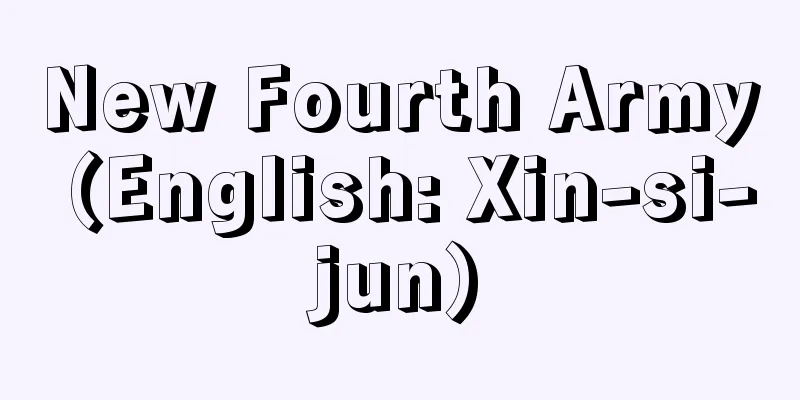New Fourth Army (English: Xin-si-jun)

|
Abbreviation for the New Fourth Army of the Chinese National Revolutionary Army. After the main force of the Red Army left for the Long March in October 1934, the remaining Red Army units in Central and Southern China continued guerrilla warfare. After the establishment of the Anti-Japanese National United Front, the main force of the Red Army was organized into the National Revolutionary Eighth Route Army under the Nationalist Government led by Chiang Kai-shek in August 1937, and the New Fourth Army of the National Revolutionary Army was organized in October of the same year with these Red Army forces in Central and Southern China as the main force. With Ye Ting as commander and Xiang Ying as deputy commander and political commissar, the army established its headquarters in Nanchang in January 1938 with a force of 10,300. It continued to develop in this region where the forces of the Japanese Army and the Kuomintang Army were intertwined, and by the end of 1940, its force had reached approximately 100,000. However, from 1939, the conflict between the Kuomintang and the Communist Party intensified rapidly, and finally, on January 7, 1941, the New Fourth Army was attacked by the Kuomintang forces in Jing County, Anhui Province, on suspicion of rebellion, and the 9,000-strong unit was devastated, with Ye Ting captured and Xiang Ying killed in action (the Anhuan Incident). The Kuomintang then cancelled the formation of the New Fourth Army on the 17th of the same month. The Chinese Communist Party immediately appointed Chen Yi as acting commander and Liu Shaoqi as political commissar, and worked to rebuild and expand the New Fourth Army, reaching a strength of 268,500 in 1945. Along with the Eighth Route Army in North China and the Anti-Japanese Column in South China, the New Fourth Army in Central China was an important pillar of the Party's military power during the War of Resistance against Japan. With the outbreak of the full-scale Kuomintang-Communist Civil War in July 1946, the New Fourth Army was organized into the East China Field Army of the People's Liberation Army, and in the fall of 1948, it was renamed the Third Field Army of the People's Liberation Army of China. Source: Encyclopaedia Britannica Concise Encyclopedia About Encyclopaedia Britannica Concise Encyclopedia Information |
|
中国の国民革命軍新編第四軍の略称。 1934年 10月紅軍主力が長征に出発後,華中,華南の紅軍残存部隊はなおゲリラ戦を続けていた。抗日民族統一戦線成立後,37年8月蒋介石の率いる国民政府のもとに,紅軍主力が国民革命第八路軍に編成されたのに続いて,同年 10月これら華中,華南の紅軍を主力として国民革命軍新編第四軍が編成された。葉挺を軍長,項英を副軍長兼政治委員とし,38年1月には南昌に司令部をおき,兵力は1万 300を擁した。その後,日本軍,国府軍の勢力が錯綜するこの地域で発展を続け,40年末には兵力約 10万に達した。しかし,39年から国共対立が急速に激化し,ついに 41年1月7日新四軍は安徽省 涇県で国府軍により,反乱のかどで攻撃され,9000人の部隊は壊滅的な打撃を受け,葉挺は捕えられ,項英は戦死した (皖南事変) 。そこで国府は同月 17日新四軍の編成を取消した。中国共産党はただちに陳毅を代理軍長,劉少奇を政治委員として,新四軍の再建,拡大に努め,45年には兵力 26万 8500人に達した。華北の八路軍,華南の抗日縦隊とともに華中の新四軍は,抗日戦争期の党軍事力の重要な支柱であった。 46年7月全面的な国共内戦の勃発に伴い,新四軍は人民解放軍の華東野戦軍に編成され,48年秋,中国人民解放軍第3野戦軍と改称された。
出典 ブリタニカ国際大百科事典 小項目事典ブリタニカ国際大百科事典 小項目事典について 情報 |
<<: Syndicate - syndicate (English spelling)
>>: Personnel administration - jinjigyousei (English spelling) personnel administration
Recommend
Life Insurance Line - Obonaisen
…JR East's commercial line, 75.6 km long, fro...
Sankanogoi (Yamaga Goi) - Sankanogoi (English spelling) bittern
A bird of the Heronidae family in the order Ciconi...
Yabudemaris - Yabudemaris
A deciduous shrub or small tree of the Caprifolia...
Mysidacea
…Mysidacea is sometimes used as a general name fo...
Hojo Ujiyasu
Year of death: 10/3/1571 (10/21/1571) Year of birt...
Antarctic Treaty
The Basic Treaty on Antarctica was signed in Wash...
Gold Crown (Art) - Kumquat
...Also, as in the Gaya countries, the grave good...
Spectacled bear - Spectacled bear (English spelling)
A medium-sized bear with a large white marking aro...
Meije [mountain] (English spelling)
Located on the southern bank of the Romanche River...
Articles of the New Land Survey
The Edo Shogunate's law on land surveys and de...
Mr. Kakizaki
The former name of the Matsumae clan, feudal lord...
Lacquer - Kyushitsu
〘Noun〙 ("髹" means to apply lacquer ) The...
new wave
...This kind of music was called punk rock, and i...
Vase - Kabin
〘Noun〙 (old also called "kahin") A type ...
Tantrum - Tantrum
〘Noun〙① (It is said because anger was thought to b...









